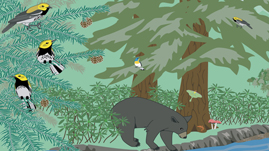Teachers' Domain - Digital Media for the Classroom and Professional Development
User: Preview


This interactive adapted from Kentucky's Natural Heritage: An Illustrated Guide to Biodiversity, introduces learners to the three levels of biodiversity: genetic, species, and ecosystem. Each layer of this interactive builds on the previous one to show learners how the three levels of biodiversity are separate but related. Clear definitions of the levels are provided, as well as examples specific to each level. Other topics covered include human-created diversity, naturally occurring diversity and species interdependence.
Take a minute and think about a team sport you enjoy playing or watching. What would happen if, all of a sudden, you were the only person on that team or your teammates decided to quit doing their jobs? Chances are you would lose.
Biodiversity within an ecosystem works similarly to a team sport. Biodiversity is the interaction between all of the organisms in an ecosystem, their differences, and how they relate to each other. Just like the members of a team, each organism has a specific role to fill. This roll is called a niche. Unfortunately, in an ecosystem, if one of the organisms is no longer able to fulfill its job, there is a lot more at stake than losing a game. When biodiversity is changed or damaged, it can cause loss of plant species that could be a source of medicine or other resource of economic importance. Plus, the bottom line is, something beautiful is being destroyed as well as a species upon which other species depended.
Biodiversity occurs in three different levels: Genetic, Species, and Ecosystem. Genetic diversity refers to the differences within members of a species and their ability to adapt to changes. Species diversity refers to the total number of plant, animal, and insect species that can be found in a particular region. Ecosystem refers to the specific natural communities and the diverse species found there. From the basic genetic level, to the broad ecosystems level, biodiversity plays an extremely important roll in our world.
Give students a list of questions you developed from the interactive. Have them view the interactive in small groups or as individuals and complete the questions.
 Loading Standards
Loading Standards